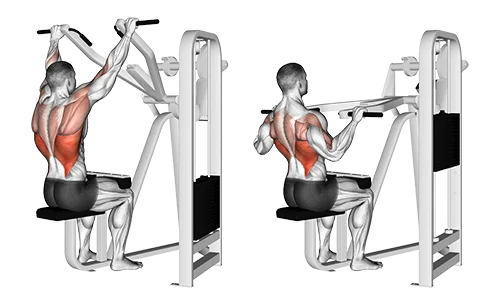The machine lat pulldown is one of the best back-building exercises you can do—whether you're a beginner or an advanced lifter. It’s simple to learn, easy to load, and highly effective for targeting the lats and improving pulling strength.
Because it keeps your torso stable, it helps isolate your back muscles more than free weight alternatives.
Muscles Worked
- Primary: Latissimus dorsi (lats)
- Secondary: Biceps, rear delts, traps, rhomboids
A well-executed pulldown helps develop the coveted V-shaped torso by building back width.
How to Do It (Step-by-Step)
- Adjust the thigh pad so your legs are secured and sit down facing the machine.
- Grab the bar with a grip slightly wider than shoulder width (overhand grip).
- Lean back very slightly and brace your core.
- Pull the bar down toward your upper chest, driving your elbows down and back.
- Squeeze your lats at the bottom, then slowly return the bar to the top under control.
💡 Think about pulling your elbows down, not just moving the bar with your arms.
Ideal Rep & Rest Ranges
| Goal | Reps | Rest |
|---|---|---|
| Strength | 6–8 | 2–3 min |
| Hypertrophy | 8–12 | 60–90 sec |
| Endurance | 12–15+ | 30–60 sec |
Pair with Auto Progression to stay consistent and grow your pull strength over time.
Form Tips
- Control the movement: No jerking or using momentum.
- Stop at the chest: Pull the bar to your upper chest—not your stomach.
- Full range of motion: Let your lats stretch fully at the top without losing tension.
- Keep shoulders down: Don’t shrug at the top—focus on keeping your shoulders packed.
When to Use It
- As a main pull exercise for upper body days
- To build width and improve vertical pulling strength
- In warm-ups or activation work before deadlifts or rows
Common Mistakes
- ❌ Leaning too far back and turning it into a row
- ❌ Using too much weight and swinging the body
- ❌ Not achieving full stretch at the top
- ❌ Letting the shoulders roll forward at the bottom
📌 Film from the side—your torso angle should stay nearly constant throughout.
Train Smarter with Volym
- Track progression with Auto Progression
- Review past performance in Workout History
- Manage rest times and tempo using the Rest Timer
A slight lean is fine, but avoid turning it into a row. Focus on controlled vertical pulling.
A wider overhand grip emphasizes back width. You can also vary grip width or use neutral grips for different stimulus.
To your upper chest or collarbone—avoid pulling too low as this shifts tension away from the lats.
Yes, especially if grip fatigue limits your ability to work your back effectively.
Absolutely. It’s easy to learn, scalable, and a great way to build foundational pulling strength.

